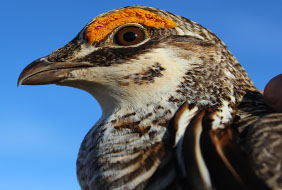FCAS Presents
Jonathan Reitz
Wildlife Biologist
Colorado Parks and Wildlife
“Translocation as a Conservation Tool for Lesser Prairie-Chickens”
Thursday, February 11th, 2021
Announcements 7:00 p.m.; Program at 7:20 p.m.
***This will be an online meeting using Zoom***
Enter the following link on your web browser at or before 7 p.m. and follow the instructions to join the meeting: https://us02web.zoom.us/j/81322534840

Lesser Prairie Chicken photo by Jonathan Reitz
The lesser prairie-chicken is an icon of Colorado's southeastern prairies. Due to a long list of environmental and anthropogenic factors, they nearly become extirpated in extreme southeast Colorado and southwestern Kansas, in an area that was considered one of the species' core areas. In an effort to recover the species on and around the Comanche and Cimarron National Grasslands, Colorado Parks and Wildlife, Kansas Wildlife Parks and Tourism, and Kansas State University partnered up and embarked on an unprecedented project for lesser prairie-chickens. Over the course of four years, a small army of biologists, wildlife technicians, and graduate students caught and translocated over 400 lesser-prairie chickens to the US Forest Service Grasslands. First and foremost, project partners wanted to take a significant step towards recovering this dwindling population on the sandsage prairie. But, another major goal was to determine if trapping and transplanting could even work and if it can be a viable "tool" that should be included in the "lesser prairie-chicken conservation tool box". In many ways, this challenging project was the first of its kind. Biologists had no idea whether or not the bird's own instincts and behaviors would get in the way of success.
Jonathan Reitz is a Wildlife Biologist for Colorado Parks and Wildlife in Lamar, CO. He has been working on lesser prairie-chicken conservation since 2006. Jonathan helps manage, research, and conserve a long list of big game, small game, and threatened/endangered species in southeast Colorado. 
